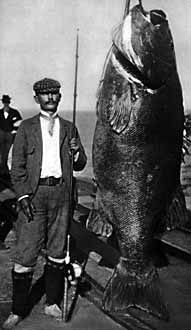|
|
|
| Black
or Giant Sea Bass (Stereolepis gigas):
... were a mainstay of California's commercial and recreational anglers until 1982 when the Leglislature afforded it Protected Species status to conserve the dwindling stocks. Their
natural environment is the deep rocky areas off the
On
the right is a picture of a Black Sea Bass (weight, 370
|
 |
| Santa
Barbara Daily News
October 23, 1925 GIANT
SEA BASS LANDED AFTER LONG BATTLE
R. A. Hendricks brought in the biggest fish of the year late yesterday afternoon, when he landed a 453-pound black sea bass at Stearns Wharf after a hard fight that lasted nearly two hours. He was fishing on the side of the wharf opposite the pile driver when the big fish struck. He played the fish from the wharf until he had broken one of the handles on his reel and was nearly exhausted. He said this morning that the fish made forty to fifty runs out to the end of his 150 yards of line. Each time the fish apparently tired and allowed himself to be towed back to the wharf by the fisherman. Finally Mr. Hendricks jumped into a row boat that was alongside the wharf. The fish was tied to the boat and the fight continued. Several times the big fish was worked in alongside of the boat, but would suddenly break away for another run. A small .22- caliber rifle was brought into play as the fish came alongside of the boat for the final time and five shots stopped the fight. The fish was hauled up the stairs to the wharf and then brought to J. L. Hendricks' store on Estado. Many Santa Barbara fishermen saw the huge fish this morning. It measured seven feet three inches from tip to tip and two feet across the tail. |
| Recent
catches:
Pictured on the right is a 43"/approximately 55# Black Sea Bass caught by Pete Wolf (Leapin' Bass) on 4/28/01 at Goleta Beach while float-tubing for halibut. It was caught with a 4 inch swimbait on 12 lb. test line. The fish was returned to the water in accordance with the Department of Fish and Game's 'clean release' recommendations. Another and larger one was caught in the fall of 2003 off the end of the pier and was also successfully released. Several more have been taken at Ventura pier and in the Newport-Balboa area. There is hope that these fish are beginning to reestablish their populations and perhaps their status will be upgraded sometime in the future. |
|
| Interesting coincidence:
I remembered a report by Tim Durham (Sinker) that included a picture of a Round Stingray, caught at the Rincon Seawall #2 on 5-3-02, with a large bite (see picture) out of one of its wings. Research to determine its cause indicated that the Round Stingray's "only known predators are the Northern elephant seal (Mirounga angustirostris) and Black Sea Bass (Stereolepis gigas)." Round Stingrays generally remain within a 2-5 mile area of their birth and their natural environment is in shallow/sandy areas less than 70' deep - an area they share with the Black Sea Bass during the latter's spawning season. Elephant seals in Southern California, on the other hand, come inshore only at the rookeries in the Channel Island which are some 20 miles or more off the coast. So it seems likely that the ray's attacker was a Black Sea Bass. |
 |